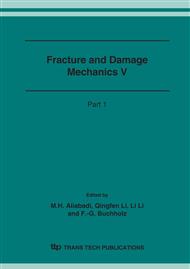p.603
p.607
p.611
p.615
p.619
p.623
p.627
p.631
p.635
MMM Fatigue Damage Evaluation and Life Prediction Modeling for Ferromagnetic Materials
Abstract:
The metal magnetic memory (MMM) technology, based on the magneto-elasticity and magneto-mechanical effect theory, has been applied to remaining fatigue life prediction. The correlation between fatigue life and MMM parameter has been investigated through rotary bending fatigue experiments. Steel X45 samples, with artificial cracks of different depth and breadth, are tested with MMM method. Based on the results of the metallographic examination, the feasibility of remaining fatigue life prediction is studied. A new remaining fatigue life MMM model of ferromagnetic material is presented. The proving experiments show the maximum error of remaining fatigue life is 4.58% between MMM model calculation and the actual life. The agreement of remaining fatigue life predicting values and testing values is found to be quite good.
Info:
Periodical:
Pages:
619-622
Citation:
Online since:
November 2006
Authors:
Keywords:
Price:
Сopyright:
© 2006 Trans Tech Publications Ltd. All Rights Reserved
Share:
Citation:


